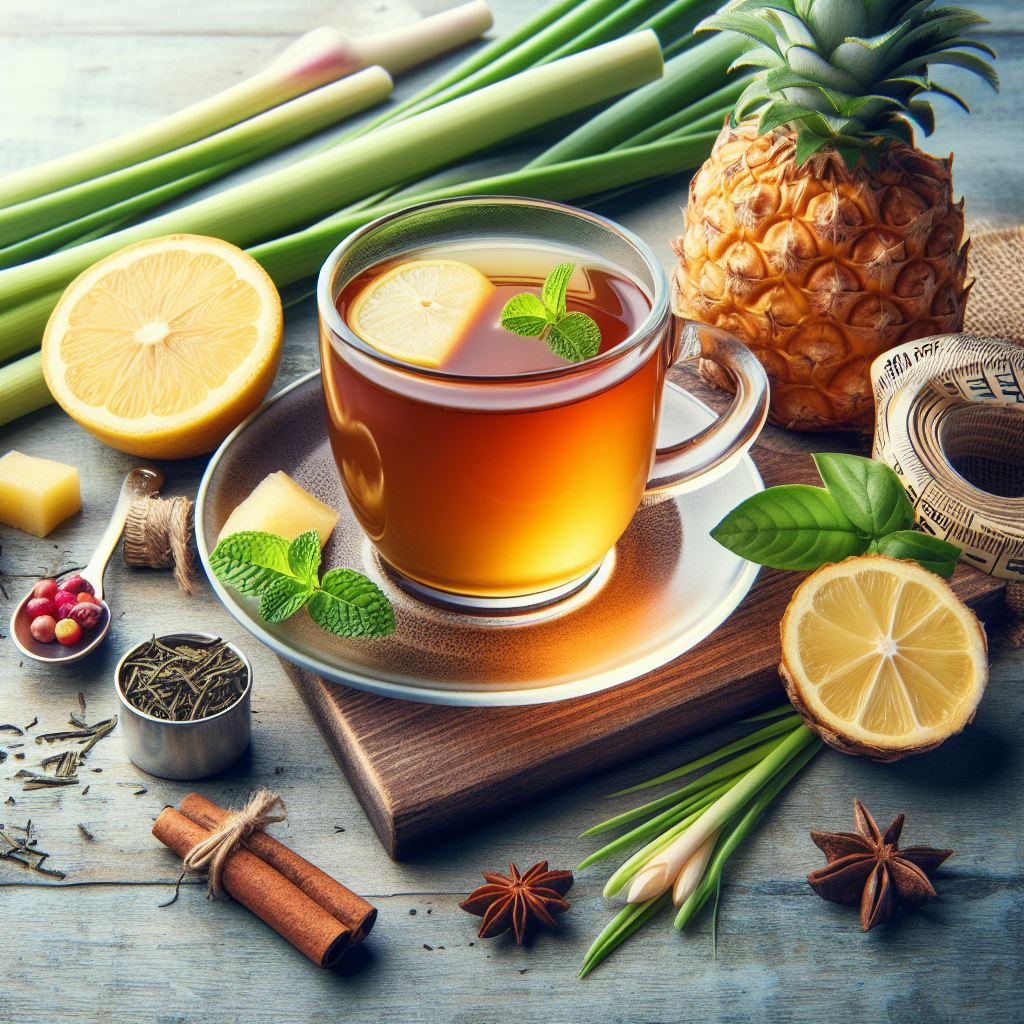If you are looking for a rich and nutritious tea with Asian origins, you might want to try black soybean tea, also known as kuromamecha in Japan. This unique tea is made from roasted black soybeans (kuromame), giving off a deliciously nutty and slightly sweet flavor. Not only is it yummy, but it has a variety of health benefits to keep the doctor at bay! Keep reading and we will dive straight into the recipe, health benefits, and more!

Black Soybean Tea (kuromamecha)
Since moving to Asia, I’ve had a bit of an obsession discovering the many unique Asian teas. So when I discovered black soybean tea, I was instantly hooked from its mesmerising deep brown color that resembled coffee. And as someone who likes coffee but struggles to drink too much caffeine, this drink was a nice caffeine-free alternative, somewhat similar to coffee. It has a nutty flavor, sweet undertone, and gives a gentle boost of energy without the jitters or the acidity. Moreover, It also has a soothing and comforting quality, especially on cold days.

The origin of black soybean tea as a beverage is not clear, but it is likely that it was developed in Japan, where both kuromame and tea culture is prominent. However, what we do know is, it’s a popular drink in Japan, especially during the New Year, as consuming kuromame is thought to bring good luck and longevity. So without stalling anymore, let get right into making this wonderful recipe!
Ingredients:
Making black soybean tea is super easy and fun, and all it requires is a few simple ingredients. Alternatively, you can buy kuromame soybean tea bags. However, the taste and intensity cannot compare to the fresh and authentic recipe. So before we get started, you will need the following ingredients:
- Black soybeans: You can find black soybeans in Asian grocery stores, health food stores, or online. They are also known as black turtle beans, black matpe beans, or black gram beans. You will need about 1/4 cup of black soybeans for every 4 cups of water.
- Water: You can use tap water, filtered water, or bottled water, depending on your preference and availability. The quality of water can affect the taste and aroma of your tea, so choose the best option you have.
- Sweeteners (optional): You can add honey, sugar, or other sweeteners to your tea, if you like it sweeter. However, I recommend tasting the tea first before adding any sweeteners, as it already has a natural sweetness from the black soybeans. You can also adjust the amount of sweeteners according to your taste and health goals.
Equipment:
To make black soybean tea, you will also need a few pieces of basic equipment. Don’t worry though, most households will have these items, and if not, some alternatives. Here’s a short list of all the bits and pieces you will need. I will also include some alternative methods, just in case:
- A saucepan: You will use a saucepan to boil the black soybeans and water. You can use any size of saucepan, as long as it can hold enough water to cover the beans. A medium-sized saucepan should be enough for 4 cups of water and 1/4 cup of black soybeans.
- A strainer: You will use a strainer to separate the tea from the beans. You can use a fine mesh strainer, sieve, cheesecloth, or a coffee filter, depending on what you have and how smooth you want your tea to be. A fine mesh strainer will give you a clear and smooth tea, while a cheesecloth or a coffee filter will give you a more cloudy and textured tea. Alternatively, you can check out our post on How To Strain Tea Without a Strainer: 7 Easy Methods.
- A teapot: Lastly, you will need a teapot to serve and store your tea. Any teapot is fine, such as ceramic, glass, or metal. If you dont own one, you can always just use a pitcher, a jar, or a bottle. Just make sure it can withstand the hot temperatures. Something with a lid will also help keep your tea warm and fresh.
Step-by-Step Instructions for Black Soybean Tea
Now that you have all the ingredients and equipment ready, it’s time to begin! You will need to set aside a good portion of your day to soak the black soybeans. So this recipe does require a small level of patience. Other than that, it is a relatively straightforward recipe. I will break down each process for you with step-by-step instructions to make it as easy as possible:

1. Preparing the Black Soybeans
- First, rinse and inspect the black soybeans, and remove any dirt, debris, or damaged beans. If you like, you can also sort out any beans that are too small or too large, as they might affect the cooking time and the flavor of your tea.
- Soak the black soybeans in water overnight, or for at least 8 hours. This is important as it will soften the beans and make them easier to cook. Not only this, it will reduce the cooking time and the gas-producing compounds in the beans. Just use enough water to cover the beans by at least 2 inches, as they will expand as they soak. Feel free to soak the beans in a bowl, a pot, or a ziplock bag, depending on your convenience. You can also store the beans in the refrigerator while soaking, to prevent spoilage.
2. The Boiling Process
- Once soaked, transfer the black soybeans to a saucepan, along with the water they were soaked in. I feel like this increases the flavor intensity, however, you can also use fresh water, if you prefer. The water should cover the beans by at least 1 inch, as they will absorb some of the water during cooking. You can add more water later, if needed, to adjust the strength of your tea.
- Over high heat, bring the water to a comfortable boil. Then, lower the heat and simmer the beans for about an hour, or until they are soft and tender. To check the readiness of the beans, try biting into one, or pressing it between your fingers. It should be easy enough to mash, but not mushy. You can also taste the water to see if it has a rich and dark flavor. If not, you can simmer the beans for longer, or add more water, as desired.
- Turn off the heat and let the beans and the water cool slightly. You can also transfer them to a heatproof container, if you want to cool them faster.
3. Straining the Kuromame
- Strain the tea to separate the liquid from the solid beans. You can use a fine mesh strainer, sieve, cheesecloth, or a coffee filter, depending on your preference and availability. Place the strainer over a bowl, a pitcher, or a teapot, and pour the beans and the water through it. You can also use a ladle or a spoon to scoop out the beans and the water, if you don’t want to pour the whole pot at once.
- Squeeze or press the beans gently to extract as much liquid as possible. You can also save the beans for later use, as they are edible and nutritious. You can eat them as a snack, or add them to salads, soups, or stir-fries.
4. Sweetening the Tea (optional)
- Allow the tea to cool slightly, or to your preferred temperature. You can also refrigerate the tea, if you want to drink it cold.
- Add sweeteners like honey, sugar, or other sweeteners to your tea, if you like it sweeter. However, I recommend tasting the tea first before adding any sweeteners, as it already has a natural sweetness from the black soybeans. You can also adjust the amount of sweeteners according to your taste and health goals. Personally, I think adding a dash of maple syrup compliments the rich earthy flavors. And if you want to push the boat out, you could try something different like adding dates as a sweetener. Learn more and check out our article on How to Use Dates with Tea: A Sweet and Healthy Guide.
5. Serving the Tea
- Pour the tea into your favorite teacups or a teapot. And dont be afraid to reheat the tea if you want to drink it hot.
- Garnish with a few whole black soybeans for visual appeal. Alternatively, If you want to try it as iced tea, just wait for it to cool and fill a glass with ice cubes.
- Enjoy your black soybean tea, and savor its nutty and slightly sweet flavor.
Tips to Make Your Black Soybean Tea Even Better
On the surface, black soybean tea may seem like a complex drink. But as you can see, it’s actually very simple to make once you get into it. Not only is it simple, it’s also a versatile drink that can be customized to your liking. So feel free to experiment to your hearts content! However, here’s a few tips and variations to get you started when making your kuromamecha even better.

Tips:
- Adjust the sweetness: You can add more or less sweeteners to your tea, depending on your taste and health goals. You can also use different types of sweeteners, such as maple syrup, agave nectar, or stevia, for a different flavor and sweetness level. As mentioned before, you could also try something different like adding dates to your tea.
- Adjust the consistency: You can add more or less water to your tea, depending on how strong or weak you want your tea to be. You can also use milk, cream, or plant-based alternatives, such as almond milk, soy milk, or oat milk, for a creamier and richer texture and taste. Give it a go!
- Add ginger: You can add some fresh or dried ginger to your tea, for a spicy and warming kick. Ginger can also give added benefits, like boosting your digestion, immunity, and circulation, as well as relieving nausea and inflammation.
- Add other spices: Try taking more of a chai approach and add some other spices to your tea, such as cinnamon, cardamom, cloves, or nutmeg. This can give it a complex and aromatic flavor. Spices can also give some added health benefits, especially if you have a cold or flu!
- Add lemon or lime: You can add some lemon or lime juice or slices to your tea, for a refreshing and tangy twist. Lemon can also enhance the absorption of iron from the black soybeans, as well as detoxify your liver and alkalize your body!
Serving Suggestions for Black Soybean Tea
Because black soybean tea is a versatile drink with rich and complex flavors, certain foods tend to complement it very well. It can be enjoyed at any time of the day, with a variety of meals or snacks! Just in case you want to try out your tea with some nice foods, i’ve included a list of food ideas that pair well with kuromame tea:

Food that pairs well with kuromamecha:
- Breakfast: Try drinking black soybean tea with your favorite breakfast foods, such as toast, oatmeal, pancakes, or eggs. Black soybean tea can also replace your morning coffee, for a tasty caffeine-free alternative.
- Lunch: Black soybean tea works great with your lunch, especially if you have a light or vegetarian meal. For example, salads, sandwiches, or soups. Kuromamecha can also balance out the spiciness or greasiness of some dishes, such as curry, pizza, or burgers.
- Dinner: If you are into your Japanese or Asian-inspired meals, then this tea if a perfect addition. For example, sushi, ramen, or stir-fry’s work really well. Black soybean tea can also complement the richness or sweetness of some dishes, such as teriyaki, katsu, or tempura. I feel like it can also help you digest your food better, and somewhat prevent bloating or indigestion.
- Dessert: Try drinking black soybean tea with your desserts, especially if you have a sweet or fruity treat, such as cake, pie, or ice cream. You could even try adding kuromamecha to some desserts to enhance the flavor and texture, such as pudding, custard, or the Japanese mochi cake.
- Snack: I think black soybean tea works well with certain snacks too, especially if you have a crunchy or salty snack, such as chips, popcorn, or nuts. It can also satisfy your sweet tooth, as it has a natural sweetness from the black soybeans.
Health Benefits of Black Soybean Tea
As mentioned before, black soybean tea is not only tasty, but also good for you. It has a variety of great health benefits that will make you want to drink this all the time! Here are some of the potential health benefits that you can get from drinking this tea:

Kuromame health benefits:
- Antioxidants: Black soybeans are high in anthocyanins, a type of flavonoid that gives them their dark color. Anthocyanins have anti-inflammatory, anti-cancer, and anti-diabetic properties, and can protect your cells from oxidative stress and damage.
- Vitamins: Kuromame is a good source of vitamin E, a fat-soluble vitamin that supports your immune system, skin, and eyes. Vitamin E also has antioxidant and anti-aging effects, and can prevent or reduce the severity of chronic diseases.
- Minerals: Black soybeans are rich in iron, calcium, magnesium, and zinc, which are essential for your blood, bones, muscles, and immune system. Iron helps prevent anemia, calcium strengthens your bones and teeth, magnesium regulates your nerve and muscle function, and zinc boosts your wound healing and infection resistance.
- Fiber: The black soybeans are also high in dietary fiber, which can improve your digestion, lower your cholesterol, and regulate your blood sugar. Not only this, fiber helps if you want to feel more full and satisfied. It’s great for preventing overeating and gaining weight!
- Protein: Black soybeans are a great source of plant-based protein, which can support your muscle growth and repair, as well as your hormone and enzyme production. Protein also helps you maintain your energy and metabolism, and can curb your appetite and cravings. So it’s a great choice for you vegetarians out there looking for protein!
Conclusion
Black soybean tea is a super delicious and healthy tea, and with a bit of patience, it is easy and fun to make at home. You will love its nutty and slightly sweet flavor, and a deep brown color. And you won’t be afraid the drink it regularly with its variety of health benefits. In fact, you can even make it in large quantities to save time and drink throughout the week!
I hope you enjoyed this article, and learned how to brew the delicious black soybean tea. If you want to mix it up, I encourage you to try customizing your black soybean tea to your liking, by adding sweeteners, milk, ginger, spices, lemon, or whatever your heart desires! Feel free to share your experiences. Go ahead and leave a comment below, if you have any questions, suggestions, or feedback. And thanks for reading!
Discover More Tea Related Articles:
- What to Do With Old Tea Leaves And Tea Bags – 9 Useful Ways
- How to Make Walnut Tea – The Traditional Tea of Gilgit Baltistan
- Blood Orange Iced Tea: A Simple Recipe For The Sweet Tooth
- Why Do Tea Bags Float? 5 Surprising Reasons
- How to Make Beetroot Tea: A Healthy Vegetable Brew





Leave a Comment